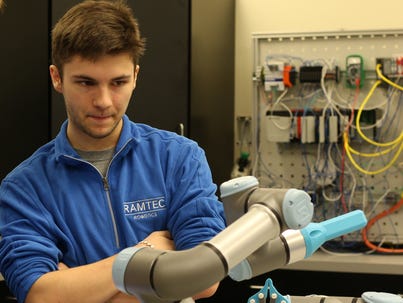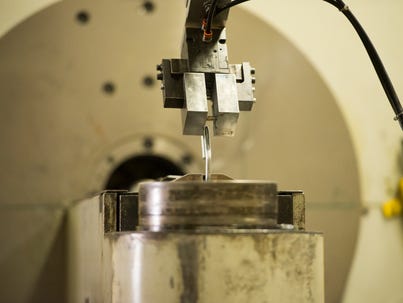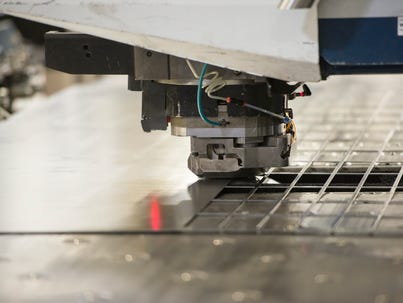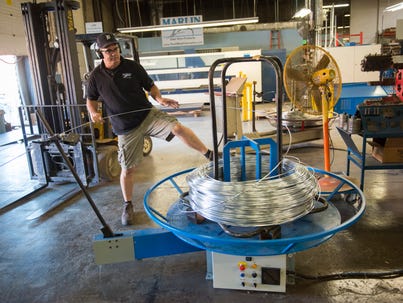Automation puts jobs in peril
Source: Nathan Bomey
 The patter of automated machinery fills the air inside wire-basket manufacturer Marlin Steel’s bustling factory in a rugged industrial section of this city.
The patter of automated machinery fills the air inside wire-basket manufacturer Marlin Steel’s bustling factory in a rugged industrial section of this city.
Maxi Cifarelli, 25, of Baltimore, peers through safety goggles at a flat screen, her left knee bent and heel resting on her chair.
Two years after earning a fine arts degree from Towson University with a specialty in interdisciplinary object design, she now spends her work days working with a personality-free machine with a name to match: a computer numerical control, or CNC, router.
With automation poised to sweep through the economy, some fear that it will kill more jobs than it creates.
But Cifarelli’s experience is the opposite. She befriended automation, instead of fighting it, and she has a job because of it.
“I haven’t named it,” she said, peering over at the robotic machinery. “I should name it.”
Cifarelli is one of 33 employees at Marlin Steel, which has undergone a transformation. Employees used to make wire baskets by hand. Now automation has taken over. High-tech machines do most of the work — and the plant needs workers willing to adapt their skill sets to survive in a rapidly changing economy.

Automation has allowed Marlin Steel to thrive, but across the country, workers feel threatened. Donald Trump catapulted into the White House by giving voice to those fears and promising to save American factories and jobs by rewriting trade deals, taxing imports and removing regulations.
A robotic arm removes a section of wire from a computerized
A robotic arm removes a section of wire from a computerized two-dimensional bending machine before carrying it to an automated welder at Marlin Steel in Baltimore, which has embraced automation to remain competitive with foreign manufacturers.
(Photo: Jasper Colt, USA TODAY)
Futurists have warned for years that automation will take your job. Now it's happening, albeit in pockets, at manufacturers, warehouses and even some labor-intensive white-collar professions.
As the political debate rages over how to inject fresh energy into the American economy with Trump taking office, automation presents perhaps the greatest threat to the American economy.
But it may also reflect its greatest opportunity if workers take the Cifarelli route and embrace robotics, artificial intelligence and automation. Either way, it’s poised to accelerate — and if not here, then in foreign countries that will reap the benefits while the American economy suffers a competitive disadvantage.
About 49% of worker activities can be turned over to some sort of machine or robot, increasingly helped along by artificial-intelligence software, according to consultancy McKinsey.
About 58% of CEOs plan to cut jobs over the next five years because of robotics, while 16% say they plan to hire more people because of robotics, according to a PricewaterhouseCoopers survey.
As artificial intelligence programs proliferate, automation won't be confined to the factory floor. Positions that involve a substantial amount of predictable work, such as data processing, could succumb to automated software and artificial intelligence.
McKinsey counted more than 70 entire professions in which at least 90% of activities can be automated, ranging from mail clerks to ophthalmic lab technicians, tire-repairers, butchers, food preparers and bakers.
But many Americans don’t think they need to adapt, with 80% saying their job definitely or probably will exist in its current form in 50 years, according to the Pew Research Center.
“We often think about automation as applying to front-line, low-wage, low-skill activities and jobs — and what we’ve discovered is there are some activities that are high-wage, high-skill that are actually very susceptible to automation,” said Michael Chui, a McKinsey Global Institute partner in San Francisco who studies the issue. “Almost every job in the economy has a significant percentage of activities that can be automated."
The professional service robot industry expects to sell a third more units from 2016 through 2019 — 333,200 in all — than it sold in the past 17 years, says the International Federation of Robotics. They could be used in place of professionals, whether it's medicine, agriculture, hospitality or even the supermarket down the street.
Consider:
—Restaurant workers. In fast-food, San Francisco-based Momentum Machines already makes a hamburger-flipping robot. Several chains are gradually introducing self-ordering stations.
—Shelf stockers. In stores, San Francisco-based Bossa Nova Robotics has developed a robot that is checking shelf inventory in a test at Lowe’s, the home-improvement chain.
—Journalists. Automated Insights has created a software suite called WordSmith that writes thousands of automated stories every month, including Minor League Baseball game accounts and earnings reports for the Associated Press, basketball game recaps for Yahoo! Sports and financial content for dozens of other clients.
—Bookkeepers. Accountants — perceived as a steady 9-to-5 job with an average salary of $67,190 in 2015, according to the Bureau of Labor Statistics — are poised for a total makeover. About one in five people in the finance and insurance sector primarily perform data processing — and about 85% of that work can be automated, McKinsey estimates.
Predictability
“The basic gist of it is the more certainty your job entails the more likely is to be automated out,” said Mary (Missy) Cummings, a Duke University professor and director of the Humans and Autonomy Lab.
In other words, the more predictable your daily routine is, the more likely your job is to go away.
It’s already happening. Walmart announced plans in September to cut 7,000 bookkeeping and store accounting positions as it automates cash management and centralizes the process at its headquarters.
In accounting, nimble firms will transition their focus to advising clients based on insights gleaned from automated data. Audits may go from an annual process to a continuous action. Software will increasingly handle the “high-volume, routine, non-judgmental” activities in real time, said Bill Brennan, audit transformation leader for PricewaterhouseCoopers.
PwC is now hiring employees for its auditing business with backgrounds in science, technology and engineering.
“We need those individuals to help us as we get into data analysis, analytics, data security, cloud computing. The future employee is going to have a combination of those skills,” Brennan said.
Cifarelli knows. At Marlin Steel, her college-level education pays off in production work. Pecking periodically at a computer mouse, she delivers detailed instructions, programming the machine to carve small canyons in wood to hold wire that is later welded together with automated equipment to make precision wire baskets, accurate to within 2/1000ths of an inch.
She's bonded with her CNC, which she has come to think of as a robot companion.
“I need the robot to ensure consistency,” Cifarelli said. “Over the past year, I’ve become really accustomed to the sounds and the movements of it. I can really predict what’s gonna happen. We’re kind of a team.”
For Marlin Steel, the problem was straightforward: Automate or die. In the early 2000s, factory workers at the 48-year-old company were forming the big metal baskets typically seen in bagel shops by hand-bending wire at a rate of 300 bends per hour in a grueling manual process.
“They all had huge right arms,” Marlin Steel CEO and owner Drew Greenblatt said.
Marlin Steel in Baltimore, Maryland, was able to stay in business by automating its processes to stay competitive when many other manufacturing jobs went overseas. Video by Jasper Colt, USA TODAY
When emerging overseas competitors swooped in and undercut the company on labor costs, producing baskets for less than $6 each to Marlin’s $12, sales cratered.
“Our entire business model blew up and we were hemorrhaging,” Greenblatt said. “China was exporting baskets into Manhattan for cheaper than I could buy the steel.”
To fight back, the company purchased robotic wire-forming machines and other automated equipment to manufacture precision wire baskets and other metal products for customers that required a higher-quality product, such as Boeing, General Motors, Harley-Davidson and Disney.
Because of automation, Marlin Steel nearly doubled its workforce over the last decade to 33 employees and boosted pay from minimum wage when Greenblatt acquired the company to at least $15 per hour today, with some employees making more than $30.
“It’s only viable because my employees are like on steroids,” Greenblatt said. “All of a sudden they’re super productive and it’s because we’ve given them the tools — it’s robotics and automation. Thank God for robots. If it wasn’t for robots, these guys would be unemployed.”
Foreign competition
Marlin Steel may have been ahead of its time.
Industrial robots have hit an inflection point — powered by cost reductions and technological improvements in visioning, sensing and gripping — and are poised to accelerate. Although they only perform 10% of tasks in manufacturing today, they will perform 25% by 2025, according to a study by Boston Consulting Group.

A computerized puncher stamps pieces out of sheet metal at Marlin Steel in Baltimore, which has embraced automation to remain competitive against foreign manufacturers.
(Photo: Jasper Colt, USA TODAY)
In one tangible sign of increased automation, those technological improvements have ushered in the dawn of the “collaborative robot,” unleashing automation from protective cages and placing the machinery right next to humans, with sensors protecting the worker and ensuring efficiency. Barclays analysts estimate that global sales of so-called “cobots” will balloon from 4,100 units and $120 million in 2015 to 701,000 and $12 billion in 2025.
And it's happening globally. China, for example, is not wasting any time. Amid all the political consternation over alleged currency manipulation and global trade advantages, China is expected to double its installation of industrial robots from 75,000 in 2015 to 150,000 in 2018, nearly four times the rate of North America, according to the International Federation of Robotics.
Trump has repeatedly pledged to bring manufacturing back to the U.S., even suggesting that Apple’s iPhone could be made here and exhorting Apple CEO Tim Cook to do so. But that might not be possible without massive automation to make it cost-effective to manufacture in the U.S.
Apple’s iPhone manufacturer, Foxconn, in fact, has already begun automating certain work that was previously done by hand. A Chinese government official told a Hong Kong newspaper in May that Foxconn had replaced 60,000 workers with robots at one factory there. And the company is receiving incentives north of Shanghai in the eastern-central Jiangsu Province to accelerate investments in robotics to replace human labor, according to Chinese state media organization Xinhua.
As automation advances, globalization will enter a new chapter in which low-cost labor becomes increasingly irrelevant. Unlike humans, robots don’t get paid an hourly wage. So it’s not much more expensive to operate a machine in a developed economy than it is in the developing world.
That could be good news for America because it may slow the outflow of investment to other countries.
“The fastest growing robotics user in the world is China because they understand that they want a lot of this manufacturing based on low-cost labor, but that’s not the whole game,” said Jeff Burnstein, president of the Association for Advancing Automation. “The game now more than ever is quality, speed and flexibility — and low-cost labor alone is not gonna do it.”
The downsides
Automation is a double-edged sword, though. Take the example of family-owned Ramsey, Minn.-based injection molder Dynamic Group.
The company recently boosted its production by 400% after installing robotic arms made by Universal Robots.
Automation bolstered the company’s capability to produce lower-volume, highly complex products that would otherwise not be profitable because the company could not afford to hire workers to craft and manufacture devices with limited commercial appeal.
“It’s really hard to be able to be competitive nation- and worldwide coming from this market and having to do that type of labor,” said Joe McGillivray, CEO of Dynamic Group, whose father co-founded the company in 1977. “We’re able to do more work, which will allow us to make more money and pay you better.”
Still, the downsides of automation are impossible to ignore. As advanced manufacturing companies adopt more automation, many workers won’t be needed.
Nathan Myers operates a two-dimensional bending machine

Nathan Myers operates a two-dimensional bending machine that bends steel wire of various thicknesses into a specific radius for Marlin Steel in Baltimore.
(Photo: Jasper Colt, USA TODAY)
McGillivray said that by installing robots, Dynamic Group expects to reduce its reliance on temporary workers. In the past, the company had occasionally hired up to 20 temp workers to aid its permanent staff of 106 workers.
“We would instead be using robots as our flex labor instead of people as our flex labor,” he said.
Artificial intelligence
If automation evokes imagery of robots replacing humans, then its close relative, artificial intelligence, conjures fears of computers taking dominion over humans.
But those fears, while perhaps not unfounded in the distant future, fail to reflect AI’s emerging role as an assistant to people in the workplace.
At Boston-based start-up Lola, two executives who were almost single-handedly responsible for replacing travel agents with computers — that is, one of automation’s most obvious examples of displacement — are reviving the travel agent through artificial intelligence.
The 50-person company has developed an AI-based system — which basically just means a bunch of software algorithms — to aid human travel agents in making recommendations to travelers, booking accommodations and addressing itinerary hiccups.
“We think most travelers would rather talk to a human because the human will understand them 100% of the time, so we use the bots to back them up,” said Lola CEO Paul English, who co-founded travel listings site Kayak.com and served as the company’s chief technology officer. “If we’re successful we’ll have thousands of travel agents, perhaps tens of thousands of travel agents working exclusively for Lola.”
The AI, which English affectionately refers to as a bot, can crawl through a user’s email inbox, for example, to identify travel preferences and scheduling quirks. Those insights are translated into intelligence that the travel agents use to improve their customer's experience.
For Lola Chairman Barney Harford, former CEO of travel booking site Orbitz and former executive at Expedia, it’s a sharp turn from his previous life ushering in the age of do-it-yourself travel.
“We are bringing humans back into the picture,” Harford said.
Part 2
How to make your job automation-proof
For Canyon Gamble, robots aren’t the enemy — they’re a ticket to prosperity.
The 19-year-old last year chose a decidedly high-tech career path, completing a special automation certification program at the tech center known in Marion, Ohio, simply as RAMTEC. It's already paying off.
“I’ve had two or three job offers just in the past month,” he said, noting chances to work on computer-aided design (CAD) and 3D CAD. “I don’t need a college degree just because of how the field works. If you can prove you can do it, you most likely can get the job."
At a time when automation is poised to eliminate entire professions across America, students like Gamble and some industry professionals are trying to outrun the revolution.
For workers to survive with good jobs that are increasingly automated, it's worth considering the old adage: If you can’t beat ‘em, join ‘em. Or in this case, gain skills in programming, maintaining or fixing industrial robots or automated software.
One strategy is to embrace a profession with little predictable work.
Canyon Gamble of Marion, Ohio, reviews a three-dimensional

Canyon Gamble of Marion, Ohio, reviews a three-dimensional gripper he developed for a Universal Robot arm through training at the Tri-Rivers Career Center’s Robotics & Advanced Manufacturing Technology Education Collaborative in his hometown.
(Photo: KimAronson.com)
A study by consultancy McKinsey found more than 70 professions in which no more than 10% of activities are susceptible to automation based on currently accessible technology.
Those automation-proof jobs include posts such as special education teacher, transit police, tree trimmer, purchasing agent, multimedia artist and animator, psychiatrist, occupational health specialist, mathematician, music director, economist, astronomer and clergy.
Adapting may be the only way to avoid tumbling into unemployment as automation sweeps workers out of entire fields. The good news: Automation technology jobs are lucrative.
Careers in advanced manufacturing automation range in salary from $40,000 to $60,000 for high-school grads with certification from a center like RAMTEC and from $50,000 to $70,000 for associate degree grads from junior colleges with similar training, said Paul Aiello, director of certified education training for Japanese robotics maker Fanuc.
By contrast, the national median compensation for Americans with only an associate's degree is $41,496, while the median compensation for someone with only a high school diploma is $35,256, according to the Bureau of Labor Statistics.
Not all of this critical training comes in classrooms. Some workers manage to figure it out on their own.
Joshua Wallace, 33, a robotics technician at Marlin Steel in Baltimore, taught himself how to improve some of the company’s robotics systems by watching videos on YouTube.
“If I run into a problem it’s amazing — just jump online. I jump on a forum,” says Wallace, an Army veteran of Afghanistan and Iraq. “Surprisingly there’s a couple things I just learned that would have really helped out months ago and a three-minute video shows me how to break it down and do it. I’m like, 'Oh my, it’s so simple.'”
Another way to keep the automation revolution from swallowing your job is to devise a role that turns the tables on tech.
Mari Vance did. Vance, 25, of Las Vegas, recently had her hours cut almost in half, from full-time to part-time, working as a parking booth attendant when the hotel-casino where she worked installed an automated ticketing booth.
Needing more work, she left her job and struck out on her own. She decided to design a role-playing game for computers, raising more than $15,000 through crowd fundraising site Kickstarter to create a visual novel video game called Dragon Date, using self-taught skills.
“I have a theory that 20 years from now we’re all going to be technicians and all the service jobs are going to be automated,” she said. "In the long term, I feel like creative jobs and stuff like that are the jobs that are most immune to automation."
She's got a point. The pace of advanced robotics installation is expected to go from 2% to 3% annual growth today to 10% growth within a decade, according to Boston Consulting Group.
RAMTEC is an Ohio technical center that offers high school students training in the field of robotics and advanced manufacturing technologies.
That’s what happened at RAMTEC, which stands for Robotic Advanced Manufacturing Technical Education Collaborative.
Chuck Speelman, superintendent of the Tri-Rivers Career Center, said the organization realized several years ago after a series of candid conversations with local manufacturers that its robotics program was not teaching marketable skills or using up-to-date equipment.
“They pretty much told us that what we were doing was a waste of time,” he said. “We had to change the paradigm.”
In partnership with robotics companies, local manufacturers and educators, Tri-Rivers Career Center designed a system that is now being replicated throughout the state.
High school students enrolled for free at RAMTEC continue earning their traditional diplomas while also collecting skills that local businesses such as global automaker Honda, which has plants in Ohio, and robotics refurbishing firm Robot Works are demanding.
Companies are pitching in. For example, Fanuc donated software training programs and sold cutting-edge robotics systems to RAMTEC at a steep discount. The company already trains about 8,000 to 9,000 people annually through its own network of paid courses, but is running at 99% capacity.
“We can’t keep up,” Aiello said. “The only way to put a dent in the demand is to partner with education.”
| }
|